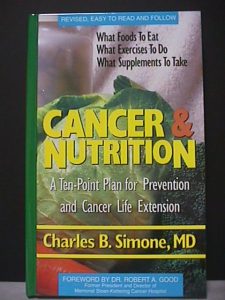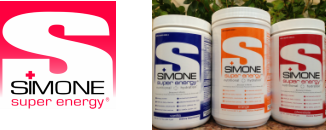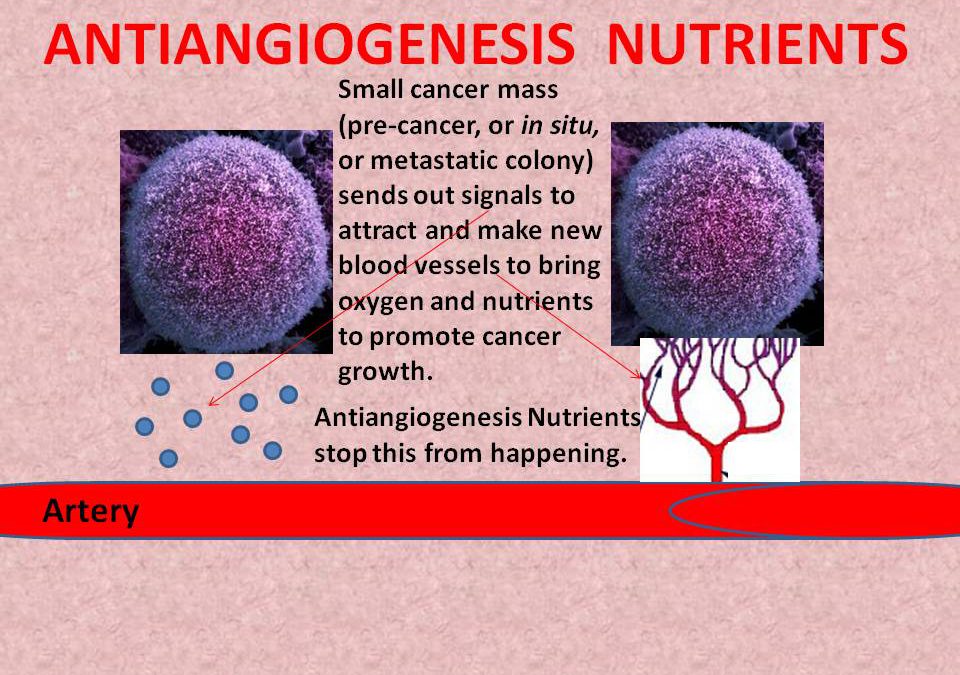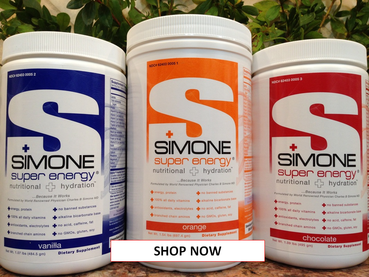We do not diagnose disease or recommend a dietary supplement for the treatment of disease. You should share this information with your physician who can determine what nutrition, disease and injury treatment regimen is best for you. You can search this site or the web for topics of interest that I may have written (use Dr Simone and topic).
“We provide truthful information without emotion or influence from the medical establishment, pharmaceutical industry, national organizations, special interest groups or government agencies.” Charles B Simone, M.MS., M.D.
ANTIANGIOGENESIS NUTRIENTS
Excerpted with permission from Cancer and Nutrition by Charles B. Simone, M.MS., M.D.

Lawrenceville, NJ – (Dr Charles B. Simone) Despite the enormous effort to combat cancer, the number of new cases of nearly every form of cancer has increased annually since 1900. From 1930 to the present, despite the introduction of radiation therapy, chemotherapy, and immunotherapy with biologic response modifiers, despite CT scans, MRI scans, and all the other new medical technology, lifespans for adults with almost every form of cancer except cervical cancer and lung cancer have remained constant, that means there has been no significant progress in treatment for adult cancers. Each month, it seems, new therapies are trumpeted. Some show promise, others fizzle quickly. The cost to treat cancer will rise to hundreds of billions of dollars annually. The obvious answer to this problem is prevention and risk factor modification. Antiangiogenesis is one component to prevention.
We were first to use antiangiogenesis to treat cancer patients using shark cartilage – this was done in Cuba.
CANCER ANGIOGENESIS
Every day approximately 350 billion normal cells divide in your body to form new ones. Every time one of these cells goes through the reproductive cycle, there is always a possibility that it can go awry and transform into a cancer cell, especially if you have multiple lifestyle risk factors. But usually, if the immune system is working properly, these transformed cells are killed.
But if just one of these transformed, cancerous cells escapes the immune system, it starts to grow into a small colony of cancer cells. This is called an in situ cancer – it remains in one site. This is usually a cancer of a 0.5 millimeter or so in diameter – 10,000,000 cells. Microscopic cancers are present in about 40% of women’s breasts between the ages of 40 to 50, in about 50% of men’s prostates between the ages of 50 to 60, and in about 100% of everyone’s thyroid over the age of 70. Most never become significant because of angiogenesis inhibitors (41 identified) that reside in the body(*).
Avascular Cancer Mass
At this point, the cancer is usually harmless because it has no blood vessels to remove the cancer’s wastes or to supply it with oxygen and nutrients. Hence, this in situ cancer cannot grow. Oxygen, nutrients, and wastes are diffused to and from blood vessels. So unless blood vessels are intimately in contact with the cancer cells, even the most aggressive cancer cells may remain dormant for months or years.
Vascularization of the Cancer
For the small colony of cancer cells to grow into a large detectable cancer, it must become vascularized – a process known as angiogenesis – the formation of (-genesis) new blood vessels (angio-). Angiogenesis is suppressed in healthy adults without cancer except during female menstruation, pregnancy, and wound healing. In fact, the normal vascular is quite stable with one of every 10,000 vessel cells (endothelial cells) dividing at any time having a doubling time from 47 to 20,000 days.
But angiogenesis occurs when cancer cells release a chemical substance, called Tumor Angiogenesis Factor (TAF), that induces new blood vessels to form. The doubling time for cancer vessel endothelial cells is very fast, from 2 to 13 days. Therefore, cancer antiangiogenic agents can stop cancer vascularization without affecting normal blood vessels. Inflammation also amplifies the angiogenic switch. Many substances induce or inhibit angiogenesis.
There are 60,000 miles of blood vessels and 19 billion capillaries in the human body. Existing blood vessels that are near the small group of cancer cells are stimulated by TAF to produce and send to the cancer cells small new blood vessels, capillaries that penetrate the cancer. These newly formed blood vessels feed the cancer with oxygen and nutrients, influence adjacent nonvascular cells, and, in addition, remove wastes. Now the cancer grows rapidly and becomes pink because it is being fed, oxygenated, and its wastes are removed.
Cancers can generally be detected by our technology only when they are the size of about a cubic centimeter (half inch sphere). This small spherical mass contains about one billion cancer cells.
Angiogenesis and Metastasis
As the vascularized cancer grows, it invades and destroys local tissues as well as more distant sites in the body. For a cancer to metastasize or spread to other parts of the body, it must first invade the local tissue and then the bloodstream, and finally land in a distant organ and begin the process of growth and angiogenesis all over again at that site. Cancer cells manufacture a complex series of enzymes and other proteins necessary to accomplish all this.
Angiogenesis is an integral part of the ability of the cancer cells to gain access to the bloodstream initially and then flourish in distant organs. In fact, many studies have shown that if angiogenesis does not occur, the cancer cannot metastasize.
This leads to a very important fact. When a cancer is large enough to be detected in the primary site, as with mammography, it has already developed angiogenesis and hence its cells have already spread to other organs. The larger the cancer mass, the less likely it will respond to antiangiogenic agents because it already has an extensive vascular network in place. The colonies in these distant organs are usually not large enough to be detected but are capable of growth and angiogenesis and hence susceptible to antiangiogenic nutrients and agents.
A high number of blood vessels in the cancer as seen under the microscope, correlates well with a high likelihood of spread to other organs at the time of biopsy, especially breast cancer, prostate cancer, lung cancer, and melanoma.
Inducers of Angiogenesis
Estrogen
Prostaglandins E1, E2
Interleukin 8
Vascular endothelial growth factor (VEGF)
Transforming Growth Factor-B
Angiotensis II
Plasminogen activator
Substance P
Fibroblast growth factor
Inhibitors of Angiogenesis
Aspirin, Celecoxib
Tamoxifen, Medroxyprogesterone
Interferon
Methotrexate, Bleomycin
Mitoxantrone, Bisantrene
Minocycline, Suramin
Hyperthermia
Radiation Treatment
Severe Infection
ANTIANGIOGENESIS NUTRIENTS
All nutrients listed below have been shown to suppress cancer angiogenesis and cancer growth in human as well as in cellular and animal studies.
ANTHOCYANINS, a flavonoid, inhibits angiogenesis, exhibit blue color in alkaline pH, red color in acid pH, and purple color in neutral pH.
Found in berries and grapes.
Human Studies: Topical application and consumption of berries/grapes led to improvement or decreased risk.
Dr Simone Recommendation: Anthocyanins 400 mg per day and consumption of multiple berries and grapes each day.
BETA-CRYPTOXANTHIN inhibits angiogenesis. It is related to beta-carotene and gets converted to vitamin A
Found in orange, red, or yellow foods.
Human Studies: Multiple studies show risk reduction with these foods.
Dr Simone Recommendation: Eat/drink the above foods each day.
CURCUMIN inhibits angiogenesis.
Found in the spice turmeric.
Human Studies: Phase I and II studies show encouraging results.
Dr Simone Recommendation: Curcumin 1,000 to 2,000 mg per day with food.
ELLAGITANNINS are converted to the flavonoid, Ellagic Acid, and then inhibit angiogenesis.
Found in blackberries, grapes (muscadine), pecans, pomegranate, raspberries, strawberries, and walnuts.
Human Studies: 46 men with prostate cancer, Gleason 7, were treated either with radiation or surgical removal and then began drinking every day one cup of pomegranate juice (Pom Wonderful Company Los Angeles, CA). Their prostate-specific antigen (PSA) doubling time extended from 15 to 54 months.
Dr Simone Recommendation: Eat/drink the above foods each day.
GREEN TEA CATECHINS inhibit angiogenesis
Epigallocatechin-3-gallate (EGCG) is a polyphenol and the most abundant catechin in green tea. It is a powerful antioxidant and inhibits angiogenesis. Green tea has 4 times more EGCG than black tea. EGCG at high doses can cause side effects because of caffeine. Decaffeinated green tea contains about half of the amount of caffeine compared to non-decaffeinated tea. Consuming more than 800 mg per day can cause liver and kidney damage.
Human Studies:
High grade prostate intraepithelial neoplasia 60 men were randomized to receive either placebo or 600 mg green tea catechins (2-3 cups green tea per day). 30% receiving placebo progressed to cancer whereas only 3% receiving 600 mg progressed to cancer.
Colon Adenomas removed – Those who drank 12 cups per day compared to those who drank 6 had a 50% reduction in recurrence.
Multiple other studies show benefit.
Dr Simone Recommendation: 600 mg Epigallocatechin-3-gallate (EGCG) per day with food
ISOTHIOCYANATE AND INDOLE-3-CARBINOL – both inhibit angiogenesis and both come from Glucosinolates.
Found in cruciferous vegetables – cabbage, broccoli, cauliflower, collard greens, mustard greens, radishes, Brussel sprouts, bok choy, and kale.
Human Studies: Regular ingestion of these foods by more than 600,000 people studied show decrease cancer risk.
Dr Simone Recommendation: Indole-3-Carbinol 100 mg to 200 mg per day with food + 4 or more servings of the above foods per week.
LYCOPENE inhibits angiogenesis
Found in watermelon, papaya, tomatoes, and higher amounts in cooked tomatoes.
Human Studies:
Taking 30 mg lycopene per day increases lycopene in the prostate gland.
15% reduced risk of developing prostate cancer in more than 51,000 men in Health Professionals Follow-Up Study who had the highest amount of lycopene consumption. 23% reduced risk of developing prostate cancer for those who ate more than 2 servings of tomato sauce per week.
Dr Simone Recommendation: Lycopene 30 mg per day and 2 or more servings of tomato sauce per week.
N-ACETYLCYSTEINE (NAC) inhibits angiogenesis
Cysteine is found in bananas, beans, lentils, spinach, salmon,and tuna. Cysteine in the body converts to N-acetylcysteine (NAC).
Human Studies: Multiple studies correlate risk reduction of cancer with higher blood levels of N-acetylcysteine (NAC).
Dr Simone Recommendation: N-acetylcysteine (NAC) 600 mg twice a day.
OMEGA-3 POLYUNSATURATED FATTY ACIDS (PUFA) – docosahexaenoic acid (DHA) and eicosapentaenoic (EPA) – inhibit angiogenesis by downregulating angiopoietin-2 and by inhibiting the conversion of omega-6 PUFA into angiogenesis compounds like prostaglandins and arachidonic acid.
Found in cold water oily fish like salmon, herring, mackerel, anchiovies, sardines, trout.
But omega-6 PUFA stimulates cancer angiogenesis – found in sunflower oil, peanut oil, corn oil.
Human Studies:
Decreased risk for pancreatic, breast, prostate, and colon cancer for those who obtained omega-3 PUFAs from seafood.
One large meta-analysis involving 49,661 patients with prostate cancer who consumed fish showed a 63% reduction in prostate cancer-specific mortality.
Dr Simone Recommendation: EPA 600-800 mg + DHA 100-200 mg per a 1000 mg softgel every day with food.
PROANTHOCYANIDINS, a flavonoid, inhibits angiogenesis.
Found in vegetables and fruits especially apples, blueberries, bilberries, cocoa also known as cacao (the source of chocolate), cinnamon, chokeberry, cranberry, grapes, persimmon, raspberries, and strawberries.
Human Studies: Cocoa – stable in the stomach acid.
Eating 75 gm of dark chocolate decreases angiotensin-converting enzyme by 18% (lowers blood pressure)
Eating 20 gm of dark chocolate every 3 days decreases inflammation (C-reactive protein).
Higher intake can decrease blood pressure, cancer risk, inflammation, and can extend life.
Apples/Apple juice – “An apple a day keeps the doctor away” holds true for risk reduction for cancers of the lung, colon, breast, ovary, oral cavity, larynx, lymphoma (>112,000 patients studied).
Dr Simone Recommendation: Eat/use the above foods each day especially dark chocolate and cinnamon that comes from Ceylon (non-toxic) and not cinnamon that comes from China or Southeast Asia like Saigon Vietnam – because Saigon sounds like Ceylon, you will see in big box stores “Cinnamon from Saigon.”
QUERCETIN, a flavonoid, inhibits angiogenesis,
Found in fruits and vegetables, especially red onions.
Human Studies: Case control studies, cohort studies (>450,000 participants) all show decreased risk for cancer, particularly ovarian and stomach cancer, when people ate more than 7 servings of red onions per week.
Dr Simone Recommendation: Quercetin 1,000 mg twice per day and several servings of red onions per week.
RESVERATROL inhibits angiogenesis
Found in mulberries, peanuts, red grapes, red liquids. Resveratrol is excreted in the urine within 4 hours of ingestion.
Human Studies:
Mimics the effects of caloric restriction
Resveratrol decreased IGF-I (Insulin-like growth factor-1) and IGFBP-3 (Insulin-like growth factor binding protein 3) in 40 healthy volunteers who consumed Resveratrol at 0.5, 1.0, 2.5, or 5.0 g daily for 29 days, leading to a reduction of cancer risk. The highest reduction was observed with a 2.5 g dose.
Dr Simone Recommendation: Resveratrol 1 to 2 grams per day with food.
RETINOIDS inhibits angiogenesis – there are several retinoids: retinol (vitamin A), retinoic acid, and retinyl acetate
Human Studies: Multiple studies correlate risk reduction of cancer with higher blood levels of vitamin A. Multiple studies show cancer regression using retinoic acid.
Dr Simone Recommendation: Vitamin A 5,000 IU per day.
SELENIUM inhibits angiogenesis
Found in fish, especially yellowfin tuna, Brazil nuts, chicken.
Human Studies: Multiple studies correlate risk reduction of cancer with higher blood levels of selenium.
Dr Simone Recommendation: Selenium organic form, take 200 micrograms to 400 micrograms per day with food.
VITAMIN D3 inhibits angiogenesis
Found in fatty fish.
Human Studies: Multiple studies correlate risk reduction of cancer with higher blood levels of vitamin D3.
Dr Simone Recommendation: Vitamin D3 take as much as you need of an oral supplement to raise your blood level to at least 80 to 100 ng/ml.
CONCLUSION
Without angiogenesis, cancers cannot grow or metastasize. Use these foods and their nutrients to prevent cancer, to prevent invasion of a pre-cancer (colon adenomas, prostate and cervical intraepithelial neoplasia, actinic keratosis), and to prevent cancer growth and progression. Remember, the more colorful foods you have on your plate, the healthier you will be. Prevention of cancer is simple and more cost effective than invasive cancer treatment.
REFERENCES
Anthocyanins: Bo-Wen Lin et al. Br J Pharmacology. 2017 Jun; 174(11): 1226-1243. Shumway BS, et al. Clin Cancer Res. 2008;14(8):2421–2430. Cerletti C, et al. Br J Clin Pharmacol . 2016. doi:10.1111/bcp.12943. Kresty LA, et al. Nutr Cancer 2006. 54: 148–156. Cocate PG, et al. Nutrition 2014. 30: 660–665.
Beta-cryptoxanthin: Siegel EM, et al. Gynecologic Oncology. 2010;118(3):289–294. Pandey M, et al. European Journal of Cancer Prevention. 2002;11(4):365–368. Yuan JM, et al. Cancer Epidemiology Biomarkers and Prevention. 2003;12(9):890–898.
Curcumin: Chen AL, et al. Anticancer Research. 2001;21(4):2895–2900. Carroll RE, et al. Cancer Prevention Research. 2011;4(3):354–364.
Ellagitannins: Pantuck AJ, et al. Clinical Cancer Research. 2006;12(13):4018–4026.
Green Tea Catechins: Bettuzzi et al. Cancer Res. 2006 Jan 15;66(2):1234-40. Shimizu et al. Cancer Epidemiol Biomarkers Prev. 2008 Nov;17(11):3020-5. doi: 10.1158/1055-9965.EPI-08-0528
Isothiocyanate and Indole-3-Carbinol: Büchner FL, et al. Cancer Causes and Control. 2010;21(3):357–371. Boeing H, et al. Cancer Causes and Control. 2006;17(7):957–969. Thompson CA, et al. International Journal of Cancer. 2010;126(4):992–1003. Gates MA, et al. International Journal of Cancer. 2007;121(10):2225–2232.
Lycopene: Giovannucci et al. JNCI. 2002;94(5):391–398. Grainger et al. Nutrition and Cancer. 2008;60(2):145–154. Chen L et al. JNCI. 2001;93(24):1872–1879.
Omega-3 PUFAs: Szymczak et al. Blood. 2008;111(7):3514–3521. Gong et al. International Journal of Cancer. 2010;127(8):1893–1904. Szymanski et al. The American Journal of Clinical Nutrition. 2010;92(5):1223–1233.
Proanthocyanidins: Persson IAL, et al. J Cardiovascular Pharmacology. 2011;57(1):44–50. di Giuseppe R, et al. J of Nutrition. 2008;138(10):1939–1945. Hollenberg NK, et al. J American Society of Hypertension. 2009;3(2):105–112. Feskanich D, et al. JNCI. 2000;92(22):1812–1823. Knekt P, et al. Am J of Clin Nutrition. 2002;76(3):560–568. Le Marchand L, et al. JNCI. 2000;92(2):154–160.
Quercetin: Galeone C, et al. Am J Clin Nutrition. 2006;84(5):1027–1032. Dorant E, et al. Gastroenterology. 1996;110(1):12–20. Schulz M, et al. Cancer Epidemiology Biomarkers and Prevention. 2005;14(11, part 1):2531–2535.
Resveratrol: Brown et al. Cancer Res. 2010 Nov 15; 70(22):9003-11.
Vitamin D3: Krishnan AV, et al. 2018. Endocrinol Metab Clin North Am. Jun 39(2):401-contents
(c) 2019 Charles B. Simone, M.MS., M.D.




